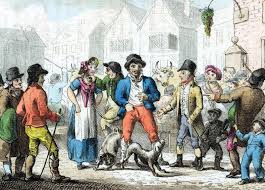Middle English Literature (1066–1485)
By 1300s, English was again the dominant language of England, and literature written in English was again common hence called Middle English Literature. By then, the language had developed into Middle English. It incorporated many French words, and displayed strong French influence in its spelling, literary expressions, and grammar, which was simpler than that of the Old English. The literature that employed this language differed markedly from the Old English literature. Old English literature tended to speak as if with one dignified voice, expressing ideals and concerns of the nobility. In contrast, Middle English literature spoke in many voices on a wide range of popular topics.

French Romances of Middle English Literature
The break with the old English literary tradition appears perhaps most strikingly in what became the most popular genre in medieval England—the Romance.
Having originated in France in the 1100s, most romances describe the adventures of legendary knights and celebrate a chivalric code that emphasize courtly love—in which a man’s love of one idealized woman makes him a better person. The heroes of romances are admirable men who, nevertheless, share the feelings and weaknesses of ordinary humans. The heroes of Old English literature can seem, by contrast, superhuman and impossibly perfect.
Working in both verse and prose, many English writers produced romances about the legendary King Arther, the War of Troy, and the mythical deeds of Charlemagne, and of Alexander, the Great. The most acclaimed verse romance of the period is Sir Gawain and the Green Knight, written in the 1300s by an unidentified poet. Its verse form evolved from the Old English practice of alliteration, or the repetition of sounds in a sequence of nearby words. It relates a comic adventure in which Arther’s finest knight undergoes a humiliating test of character.
Another outstanding Arthurian romance, also written in skillful alliterative verse is Le Morte d’Arthur (The Death of Arthur). It describes king Arthur’s legendary conquests and his eventful fall. The poem became a source for sir Thomas Malory’s prose version of the Arthurian legends, Le Morte d’Arthur (completed around 1470), possibly the finest single work of Middle English prose.
Chaucer’s Masterpiece
Perhaps the greatest English writer of the Middle Ages was the poet Geoffrey Chaucer. His long narrative poem The Canterbury Tales, written in the late 1300s, is a collection of stories told by people making a religious pilgrimage to the shrine of St. Thomas a. Becket in Canterbury. In The Canterbury Tales, Chaucer portrays a broad, colourful cross section of medieval English society.
For The Canterbury Tales, and other poems from early 1380s on, Chaucer introduced an important new verse form into English literature—the iambic pentameter. In this meter each line has ten syllables with one unstressed syllable followed by one stressed syllable in more or less regular alternation. This expressive meter would become the most widely used in English poetry.
The Beginning of Drama
English drama developed from enactment of biblical stories during church services on such feast days as Palm Sunday, and Easter. These plays sometimes drew on stories from the Old Testament of the Christian Bible, but most of them focused on the life and death of Christ.
Such plays became popular as a source of both religious instructions and entertainment. Following a papal edict in 1210 that forbade the clergy to act on the public stage, performance of these plays was to taken over by trade guilds known as “mysteries” [at that time the word “mystery” meant “trade” or “craft”]. Named after these guilds, the mystery plays evolved over time, deepening character development, and adding scenes not found in the Bible. Eventually, these plays were moved from the church to the outdoors, where the tradesmen presented them on movable platforms in the streets and town squares.
Similar but less realistic dramas called morality plays also became popular at this time. These plays served to teach a moral lesson and featured allegorical characters that represented good, evil, and other abstract qualities. The most famous morality play was Everyman written at the end of 1400s. Typically, in a morality play, a character that can be taken as a representative of humankind undergoes difficulty and imparts a lesson to the audience. Morality and Mystery plays, poems, and romances, all evidenced the powerful revival of the English language and English literature by the end of the Middle Ages. Distinguished writers such as Chaucer and Malory showed English language could be wielded to express creative vision in great works of art.
#middle english literature #middle english literature #middle english literature #middle english literature #middle english literature
Read More




